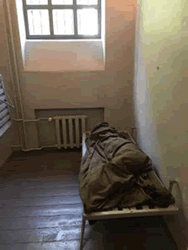|
Back to School:May 24 (Andrew Distell) We first explored more of Raseiniai, highlighted by our visit to the former prison. While the prison has not been active since 1953, it has been put to good use as a museum.We learned about the Raseiniai’s history as a Jewish cultural center (of majority Jewish population), its status as the birthplace of two revolts against the tsar, and its housing of what was once the highest and longest bridge in Europe. Additionally, the museum has rooms for artwork, clothing and old books. Tragically, what was once a thriving town was essentially demolished in the Second World War. Luckily, the museum provides a strong history of Raseiniai’s strong past. |
|
From the Israel Kaplan collection: 1) An essay by Israel Kaplan about the experiences of the Jews of Raseiniai (Yiddish: Raseyn) and several draft pages on this topic. 15 pages, handwritten (quite illegible), in Yiddish. 2) Five letters to Dr. Zemach Zemarion from Chana Vinik and Pawel – Fajvel Kagan,** with detailed information about the fate of the Jewish community of Raseiniai and the fates of specific individuals. Dated Aug. 15, 1945 through April 27, 1952. Three pages, handwritten, in Yiddish.
2) Five letters to Dr. Zemach Zemarion from Chana Vinik and Pawel – Fajvel Kagan,** with detailed information about the fate of the Jewish community of Raseiniai and the fates of specific individuals. Dated Aug. 15, 1945 through April 27, 1952.Three pages, handwritten, in Hebrew and Yiddish. The content of the letters provides the following picture: During the Soviet regime, about a week before the Germans invaded Raseiniai (June 24, 1941), the majority of [the population of] the Kamieniec yeshiva were banished to Siberia. A while after the German invasion, young Jewish men and women were taken to a camp near the town and put to work at forced labor. At the end of July 300 men were taken from the camp and shot to death near the town. Every two days a group of Jews were taken from the camp and shot (in the camp and in the town). At the end of August, the remaining Jews (in the camp and town) were ordered to go to the Biliunu Dvaras estate, and on Aug. 28, 1941, all were shot to death. The majority of escape attempts failed. One man, Nachum Zolin, succeeed in escaping. * A small amount of the material is based on the [testimony or memoirs] of Frida Praz – Miller. ** On one of the draft pages in this file, Kaplan refers to these letters thus (Tiberias, July 13, 1954): Letters about Raseiniai to Dr. Zemach Zemarion (Halperin), presently in Tiberias and previously in the Israeli [sic; Jewish] Brigade. The letters are also from Chana and Zippora Vinik: Chana now lives in South Africa. Zippora, now married to one Choronzicki of Siauliai, now lives in Israel. Fajwel Kagan now lives in Australia. Close
|
|
The materials were transferred to Yad Vashem by Koniuchowsky Leyb Scope and Content Subjects |
|
|
|
|
|
|
|
|
|
|
|
|
|
|
|

